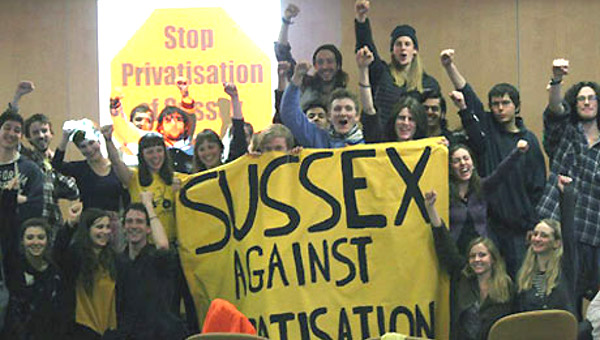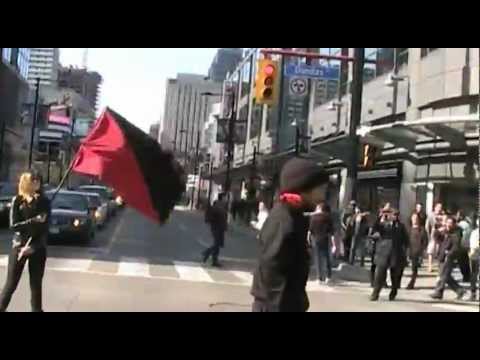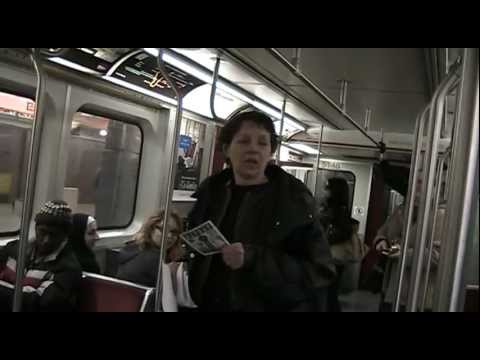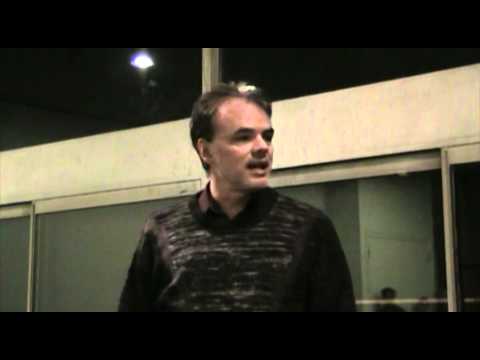Three years after the financial meltdown of 2008, the U.S. Occupy movement opened the possibility for a left regroupment against resurgent neoliberalism. Yet the forceful eviction from the squares just two months after the movement emerged, cut short the development of such a constituting power, of a historic bloc of the “99%.”
 Suddenly dispossessed of the “spatial centers of its hegemonic apparatus,” it was robbed of its basis for “(counter)hegemonic practices and functions.”1 As Jan Rehmann explains, it lost the space for the convergence and democratic, integrative practices of the diverse social forces and individuals (both organized sections of the Left, labour, social justice groups, etc.). Nor did it now have a place for its expressive practices of communal life and political education. Gone too was the space for deliberation and collaborative decision-making, as well as for developing relationships of solidarity.
Suddenly dispossessed of the “spatial centers of its hegemonic apparatus,” it was robbed of its basis for “(counter)hegemonic practices and functions.”1 As Jan Rehmann explains, it lost the space for the convergence and democratic, integrative practices of the diverse social forces and individuals (both organized sections of the Left, labour, social justice groups, etc.). Nor did it now have a place for its expressive practices of communal life and political education. Gone too was the space for deliberation and collaborative decision-making, as well as for developing relationships of solidarity.
The repression disrupted the nascent mosaic-left,2 that had began to be constructed out of the fragmented Left and progressive forces. Yet, like the mobilizations abroad, Occupy did not immediately disappear, but rather regrouped in community and labour struggles at the local and trans-local levels, fighting on the front lines of the crisis, from which it in many ways initially emerged.
Since the evictions, multiple initiatives were formed to carry forward the struggles: The “Occupy Our Homes” network combats foreclosures; campaigns to support workers’ struggles against precaritization; projects push for debt relief; and “Occupy Sandy” provided grassroots relief for victims of Hurricane Sandy, neglected by a hollowed out federal safety net. All of these post-eviction projects intervene into the broken circuits of a precarious social reproduction.
But these new projects also bring new challenges with them. Occupy had already been struggling to negotiate the tension between horizontal and vertical coordination, between strategies of rupture and those of political reform, between autonomous activity and coalition-work, and between struggles situated in civil society and those within the state. But now Occupy has a new dynamic to negotiate. How will it on the one hand, repair the broken circuits of social reproduction, while simultaneously forging a political opposition to transform the societal foundations underpinning them?
With these questions, I looked at the movement’s interventions into four specific areas.
Occupy Labour
The highpoint of the Occupy-Labour collaboration was Occupy Oakland’s (OO) “general strike” to shut down the city’s port, involving sections of organized labour, and directly supporting ILWU port workers against layoffs and management’s anti-union efforts. Yet, this success could not be repeated, as the link could not be maintained between expressions of collective anger (following the eviction of OO) on the one hand, and base-building and outreach beyond the movement’s immediate circles on the other.3
But in Chicago, active participation amongst socialist organizers and labour rank and file in the Occupy movement, did produce a cross fertilization that strengthened both sides, both the Occupy movement, and labour-community mobilizations. While unionized nurses defied police repression in the Occupy encampments, Occupy participants joined demonstrations against labour flexibilization, urban austerity, and school privatization organized by established civil society groups. And in New York City as well, “99 Pickets” worked with immigrant employees, and occupied their workplace, to defeat management’s anti-union measures.
Yet, scaling up has been a challenge. This was the case with the “99% Spring,” which emerged in April 2012 as a coalition of dozens of labour and community groups, seeking to reassert an oppositional position in the crisis and advance a broad social justice agenda. They organized popular education sessions for nearly 100,000 people about inequality, offered trainings in civil disobedience, and took action against foreclosures and in support of local workers’ struggles. They also held country-wide actions, disrupting corporate shareholder meetings of companies which have profited from foreclosures, student loan debt, wage suppression, public austerity, and ecological destruction.
Yet, there was no organic condensation of forces with Occupy. The 99 Spring’s scandalization of class polarization, and identification of popular-class interests, and its grassroots action targeting key crisis-winners, encountered the ambiguity of the Occupy movement, incapable of negotiating the tension between autonomy and coalition. Some Occupy members saw the potential to link the movement’s largely white, middle-class, student base with the predominantly working-class, people of color communities involved in the grassroots social justice organizations. And they hoped to “anchor [Occupy’s] mass public action” with “communities on the frontlines of [the] economic, political, and ecological crisis,” and to construct a plural, left-progressive bloc.4
Yet others feared participation of the liberal NGO, Move On, would mean Occupy’s “cooptation” by a “Democratic Party front group,” its integration into Obama’s re-election campaign and the restabilization of the status quo.5 And still others avoided the challenge altogether, recognizing Occupy’s influence on labour and civil society groups (ie. pulling them to the left: “Occupy co-opted Move On”), by uncritically embracing unity, embracing an uncritical absorption into an amorphous “movement,” and by obscuring the task of strategic participation in broad coalitions.
Paradoxically, it was Occupy’s lack of a functioning autonomous structure, that prevented it from negotiating the tension between independent action and coalition. As a result, much of its membership was absorbed back into other movements, and it could not make a collective, democratic decision across the movement, for how to engage with other progressive social forces, and how to maintain its call for deep social change. It could not collectively identify coalition partners with whom it could develop common goals and strategies, nor identify opponents with whom collaboration would harm the movement. Nor could it develop a “revolutionary Realpolitik” (Rosa Luxemburg), which would address everyday concerns, while developing strategies for social transformation.
Instead of a condensation of social forces into a plural left-progressive bloc, the Occupy-labour collaborations have contributed to the diffusion of a left-progressive spirit in both the positive and negative sense. On the one hand, it has inspired a new wave of labour mobilization, from the Chicago teachers’ strike to the country-wide low-wage sector upsurge amongst Walmart and fast food workers, now strengthening campaigns for living wages. Yet, while individual Occupy groups support these struggles, there has not been the formation of stable Occupy-labour coalitions beyond the local level and mostly informal networks.
Occupy Homes
The ongoing foreclosure wave became another site of intervention, both during Occupy’s encampment-phase, yet more intensively following the evictions. In December 2011, a country-wide day of action under the banner “Occupy Our Homes,” inspired multi-city actions, where civil disobedience was used to physically obstruct foreclosures and evictions, demonstrations and “occupations” of banks and mortgage lenders were held, and squats of vacant homes were opened by homeless people to provide shelter and to scandalize the for-profit housing market.
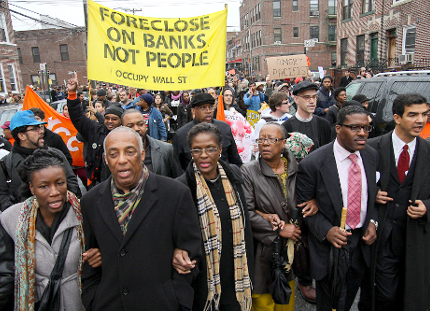 Within these struggles, direct opposition to unlawful seizures brought forth a call for an immediate moratorium on all foreclosures, at times heightening the demand for social rights to housing. All positions are present within the movement, creating a cacophony of pragmatic and transformative demands.
Within these struggles, direct opposition to unlawful seizures brought forth a call for an immediate moratorium on all foreclosures, at times heightening the demand for social rights to housing. All positions are present within the movement, creating a cacophony of pragmatic and transformative demands.
While the initiative has not reached the mobilization level of the Spanish anti-eviction movement abroad, it is nonetheless rooted in the effected communities as a defensive struggle against the passive acceptance of capitalism’s destructive tendencies. This is because the crisis of social reproduction has met the crisis of political representation, meaning that those threatened to lose the very roofs over their heads, are also defenseless in this situation, as neither the established political institutions nor the weakened advocacy social support networks (including labour) come to their aid. In this situation, threatened homeowners are literally requesting Occupy’s help, to stand in the way of eviction and police. And in multiple cases, the movement has responded affirmatively, which has elevated it to a position of leadership – at least in the symbolic sense – in a grassroots defensive battle against neoliberal crisis management.
While defending dozens of homeowners from dispossession through mortgage refinancing and principals reductions, Occupy Our Homes struggles to scale up. Occupy Minneapolis seeks to go beyond these limitations. First, they link single struggles into neighborhood resistance through the “Foreclosure and Eviction Free Zone.” Second, these struggles are connected to immediate, general, and long-term political demands (mortgage refinancing, a moratorium on foreclosures, and housing rights). And third, the civil society struggles and political demands are enhanced with a political interventionist strategy in the local state, without forfeiting the movement’s autonomy.
They are trying to shift the political consensus behind a moratorium by using the contradictions within the state, for example, by challenging the mayor’s passive support for evictions with the city council’s majority opposition to them. And they try to establish a “de facto” moratorium on the ground, by securing at least passive support from some state institutions, by calling on municipal government and police to refrain from interfering in contested foreclosures.6
Occupy Our Homes has thereby shifted the broader political consensus around mortgage debt relief. The Federal Reserve issued a white paper, calling for principals reductions for homeowners, but this has fallen on deaf ears in Washington,7 so that other state actors are now taking the initiative. Leading the fight is the working-class city of Richmond, California, whose major, supported by a strong progressive alliance, is threatening mortgage lenders to reduce principal balances on mortgages, or have them seized through the city’s “eminent domain” laws, and then refinanced at reduced rates.8 A handful of other cities are also considering this regulatory reform, that would shift the financial losses of the over-accumulation crisis away from the “99%,” and onto the profitable mortgage lenders.
Hence, Occupy has inspired a counter-neoliberal mobilization transgressing the state/civil society divide, mobilizing grassroots opposition and organizing direct action against the crisis. But it has also developed strategies of state intervention, and inspired new struggles of state actors, who seek to turn elements of the state apparatus toward defending the interests of the “99%”.
Occupy Debt
Struggles against student and consumer debt became a central focus of the movement from its beginnings. Yet, while the movement shows the impressive capacity to mobilize dissent and effect public debate, it has not been able to translate this into political achievements. This is largely due to the failure to constructively negotiate the tension between struggles situated within the state and those in “civil society,” as well as their relation to concrete forms of mutual aid and solidarity. The result has been a polarization into three distinct initiatives, each leading in different directions.
The Occupy Student Debt Campaign (OSDC) began building an autonomous debtors’ movement, aimed at using collective action of debt refusal to push for widespread debt cancellation and free public education. A second approach, by Occupy Colleges/Occupy Student Debt (OC/OSD) employs state interventionist practices, seeking to build alliances with progressive policy makers and to support congressional debt relief bills. A third project, organized by Strike Debt!, focuses on concrete material solidarity, helping to alleviate debtors of their material burdens, through purchasing their debt and voiding the contracts.
The OSDC sought to challenge deeply embedded social fragmentation, and targeted the system of debt financed education and the power of the lender industry.9 They sought to unite people for collective action with a million strong debt strike. Yet, while correctly identifying the nascent sources of power of debtors within the processes of financialized capitalism, the campaign was plagued by voluntarism.10
They focused exclusively on disrupting the passive consensus of borrowers to “debt servitude,” by building group solidarity through the rejection of the feelings of moral guilt. This however obscured the coercive structures underpinning debtors’ subordination, that is, the risk of financial ruin as result of default.
“Without linking collective action with forms of collective protection and defense – as labour and tenant unions do – mass debt refusal was impossible as it further endangered borrowers, rather than strengthening their capacity for collective action.”
It was therefore no surprise that the campaign collapsed after securing only 2,000 “pledges of refusal.” Without linking collective action with forms of collective protection and defense – as labour and tenant unions do – mass debt refusal was impossible as it further endangered borrowers, rather than strengthening their capacity for collective action. Hence, efforts to counter individualization at the ideological level were set back by the campaign’s failure to address individualization at the material level, as the legal-individual, personally responsible for contract agreements made in his or her name.11
The debt strike was rejected by other sections of the movement, for example by Occupy Colleges (OC) and the Occupy Student Debt group12 (OSD), who criticized its failure to guard against default.
If OSDC “solved” the tension between parliamentary and extra-parliamentary action by heroizing “resistance,” and decoupling it from the coercive basis of hegemony, OSD/OC simply inverted this relationship. Instead of a radical break, they pushed debt relief as an alternative economic recovery, yet pinned it to a narrowly conceived state-interventionist strategy nearly entirely divorced from extra-parliamentary relations of power.
As a result, their petition to the White House for debt cancellation was simply integrated into Obama’s own cosmetic modifications, only moderately reducing the financial burden upon student debtors,13 and thereby helping to realign the (potentially oppositional) youth base behind the President. Although substantial reforms would require a shift in the relation of forces both inside and outside of the state, OSD/OC explicitly rejected the role disruptive collective action amongst debtors might play toward these ends.
The third initiative is Strike Debt!’s14 (SD) “Rolling Jubilee.” The project’s strength lay in its effort to work against social fragmentation, by lining student borrowers with consumers burdened by credit card and medical debt, mortgage debtors, and the working poor, suffering under exorbitant payday loans. SD therefore seeks to repeat Occupy’s original success in condensing the differentially impacted popular and subaltern classes. Refocusing on the commonality across the differences, they assert that “debt is the tie that binds the 99%.” Yet, the group has not had the political reverberation they had once hoped for. The “Rolling Jubilee” uses crowd-sourced funds to purchase consumer debt on the secondary debt market, and then void the contracts, cancelling the borrowers’ obligations toward repayment. The debt purchases are framed as acts of “abolition,” but aside from the very limited nature of this mutual aid project, it also lacks the component of social convergence which animated the original occupations, and some of the other post-eviction campaigns.
The major limitation of the project however, has been its self-limitation to a do-it-yourself strategy. While mutual aid projects are critical to social movements, and toward inculcating the values of a solidaristic society and culture, the project was framed as in a limited form of a “bailout of the people by the people.” It attempts the impossible: to solve the crisis of social reproduction through voluntary associations in civil society. By avoiding the state altogether, it has been criticized for contributing to neoliberalization, and the state’s continued retreat from the responsibilities of generalized social protection. But sufficient social redress and material redistribution require more than the voluntary contributions of people’s disposable incomes – they necessitate coercive measures to re-appropriate the concentrated wealth of the “1%,” whether in the form of tax reform, wage hikes, workplace occupations, and the like, and more fundamentally through the democratization of the economy.
All three of these projects have advanced the debtors movement, but are trapped within singular logics. The dynamics between constructing an independent social power of debtors, of intervening on the terrain of the state, and of developing forms of mutual aid and solidarity, have divided off into distinct projects, fulfilled by an unproductive division of labour. The debtors’ movement hasn’t been able to develop the nascent power of debtors and has had little lasting social or political impact; state-interventionist attempts have been reincorporated into only moderate reform agendas; and contrary to the belief that struggles “outside the state” can not be incorporated into capitalism, the direct material relief of the “Rolling Jubilee” is trapped as a micro project of mutual aid that furthers the neoliberal roll-back of the welfare state. It is unlikely that these threads will congeal into an integral strategy. They appear to be stuck in an unproductive and confrontational division of labour. But, so long as the student debt crisis persists, it is likely that a new wave of mobilization will come.
Occupy Sandy
Occupy Sandy emerged as a rapid network of hurricane relief, mobilizing thousands of volunteers to fill the void left by the lax response of the federal emergency relief agencies and professional charity organizations. It generated $1.3-million of donation; it established a network of “hubs” and “distribution centers” for solidarity and redistribution of goods and services; it built connections with affected populations and common mutual aid projects. They distributed donated goods, repaired houses damaged by the flooding, and identified needs amongst public housing projects, cut off from public view.
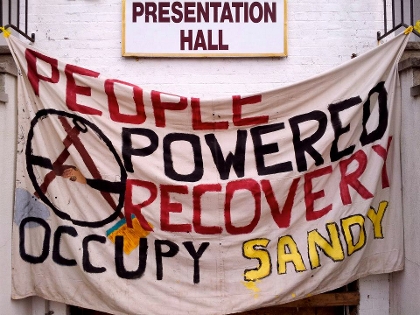 Here, they entered into the broken circuits of societal reproduction, by developing networks of direct solidarity, publicly scandalized the uneven impact of the storm on the urban population, with drastic negative social and material effects on low-income, and largely Black and Latino neighborhoods. They challenged the debt-based recovery model, the displacement of public housing residents, and called for the empowerment of the local communities in a democratic recovery process.
Here, they entered into the broken circuits of societal reproduction, by developing networks of direct solidarity, publicly scandalized the uneven impact of the storm on the urban population, with drastic negative social and material effects on low-income, and largely Black and Latino neighborhoods. They challenged the debt-based recovery model, the displacement of public housing residents, and called for the empowerment of the local communities in a democratic recovery process.
Occupy Sandy was widely praised in the media, by public officials, and from the affected populations. And it became the liaison delivering goods from state institutions and charity organizations to the affected populations. Yet, this sudden and unexpected leadership position bestowed onto the movement deluded some sections of the movement into thinking its self-organized projects were sufficient for the task of relief. As a result, a self-congratulatory, “We got this!,” became their slogan.
However, other movement participants recognized the grave limitations of a do-it-yourself relief project, and sought to connect relief with protest, linking Occupy with affected populations and social justice organizations for an alternative recovery mobilization. And affected residents also criticized Occupy’s self-delusion, and its willingness to trade in its political capital. Public housing residents told Occupy activists, “I’m tired of the free blankets. If you can’t get no officials down here, I got to go to City Hall and keep screaming.”15
The movement organized demonstrations bringing together broad community organizations but their shift toward political action was too little and too late. The thousands of volunteers who rushed to the movement in the first weeks, delivering material aid, stayed away from the “people’s recovery summit” which brought together dozens of community, labour and environmental organizations. The new Occupy relief workers did not join efforts to call for an alternative recovery process. Out of the rubble has emerged the Alliance for a Just Rebuilding (AJR), with an impressive coalition of groups. Yet Occupy Sandy failed to maintain its initial mobilizational capacity, and to connect its mutual aid projects to forms of political intervention. The AJR is now carrying the baton, but has received neither the media attention nor the popular support that Occupy Sandy originally generated.
While the movement’s network form helped mobilize thousands of new people to the movement, it couldn’t pivot toward, or connect mutual aid work with, political action. As a result, the movement has reached a plateau, and is no longer leading counter-neoliberal struggles in the same way it had in its heyday.
Conclusion
Two years after the movement first emerged, it is now clear that Occupy has not united the “99%” into a new, stable historical bloc, to overcome the crisis of neoliberal hegemony. Yet, it has contributed enormously to such a possibility in the future. It has helped to turn mass dissent into mobilization, and converged diverse social forces into temporary alignments. It has also dispersed a popular class approach, helping elevate other struggles to new levels. While the movement still exists, it is no longer leading the counter-neoliberal mobilization which it helped initiate, but rather tailing behind it like a zombie Occupy chasing a zombie neoliberalism. Whether it returns to the scene, providing a renewed capacity to condense the diverse social forces into a plural left-progressive bloc, with the desire for social transformation, remains to be seen. •
* This text will be published in the December edition of LuXemburg, and is a summary of a longer study that will be published by the Rosa Luxemburg Foundation.
* Thank you to Jan Rehmann for his helpful comments, and to Mario Candeias and the Rosa Luxemburg Foundation’s Institut für Gesellschaftsanalyse for their support.


